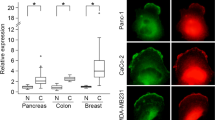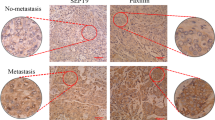Abstract
The tumor suppressor adenomatous polyposis coli (APC) is mutated in sporadic and familial colorectal tumors. APC interacts with the Rac1- and Cdc42-specific guanine-nucleotide exchange factors (GEF), Asef and Asef2, which contain an APC-binding region (ABR) in addition to Dbl homology, Pleckstrin homology (PH) and Src homology 3 (SH3) domains. APC stimulates the GEF activity of Asef and Asef2, and thereby regulates cell adhesion and migration. Here we show that Asef2, but not Asef, interacts with Neurabin2/Spinophilin, a scaffold protein that binds to Filamentous actin (F-actin). In response to hepatocyte growth factor (HGF) treatment of HeLa cells, Asef2, Neurabin2 and APC were induced to accumulate and colocalize in lamellipodia and membrane ruffles. Neurabin2 did not affect the GEF activity of Asef2. RNA interference experiments showed that Asef2, Neurabin2 and APC are involved in HGF-induced cell migration. Furthermore, knockdown of Neurabin2 resulted in the suppression of Asef2-induced filopodia formation. These results suggest that Asef2, Neurabin2 and APC cooperatively regulate actin cytoskeletal organization and are required for HGF-induced cell migration.
This is a preview of subscription content, access via your institution
Access options
Subscribe to this journal
Receive 50 print issues and online access
$259.00 per year
only $5.18 per issue
Buy this article
- Purchase on Springer Link
- Instant access to full article PDF
Prices may be subject to local taxes which are calculated during checkout






Similar content being viewed by others
References
Akiyama T, Kawasaki Y . (2006). Wnt signalling and the actin cytoskeleton. Oncogene 25: 7538–7544.
Allen PB, Ouimet CC, Greengard P . (1997). Spinophilin, a novel protein phosphatase 1 binding protein localized to dendritic spines. Proc Natl Acad Sci USA 94: 9956–9961.
Bellanger JM, Astier C, Sardet C, Ohta Y, Stossel TP, Debant A . (2000). The Rac1- and RhoG-specific GEF domain of Trio targets filamin to remodel cytoskeletal actin. Nat Cell Biol 2: 888–892.
Bienz M, Clevers H . (2000). Linking colorectal cancer to Wnt signaling. Cell 103: 311–320.
Birchmeier C, Birchmeier W, Gherardi E, Vande Woude GF . (2003). Met, metastasis, motility and more. Nat Rev Mol Cell Biol 4: 915–925.
Boccaccio C, Comoglio PM . (2006). Invasive growth: a MET-driven genetic programme for cancer and stem cells. Nat Rev Cancer 6: 637–645.
Buchsbaum RJ, Connolly BA, Feig LA . (2003). Regulation of p70 S6 kinase by complex formation between the Rac guanine nucleotide exchange factor (Rac-GEF) Tiam1 and the scaffold spinophilin. J Biol Chem 278: 18833–18841.
Cadigan KM, Nusse R . (1997). Wnt signaling: a common theme in animal development. Genes Dev 11: 3286–3305.
Etienne-Manneville S, Hall A . (2003). Cdc42 regulates GSK-3beta and adenomatous polyposis coli to control cell polarity. Nature 421: 753–756.
Feng J, Yan Z, Ferreira A, Tomizawa K, Liauw JA, Zhuo M et al. (2000). Spinophilin regulates the formation and function of dendritic spines. Proc Natl Acad Sci USA 97: 9287–9292.
Ferrara N, Kerbel RS . (2005). Angiogenesis as a therapeutic target. Nature 438: 967–974.
Fodde R, Smits R, Clevers H . (2001). APC, signal transduction and genetic instability in colorectal cancer. Nat Rev Cancer 1: 55–67.
Futter M, Uematsu K, Bullock SA, Kim Y, Hemmings Jr HC, Nishi A et al. (2005). Phosphorylation of spinophilin by ERK and cyclin-dependent PK 5 (Cdk5). Proc Natl Acad Sci USA 102: 3489–3494.
Hamann MJ, Lubking CM, Luchini DN, Billadeau DD . (2007). Asef2 functions as a Cdc42 exchange factor and is stimulated by the release of an autoinhibitory module from a concealed C-terminal activation element. Mol Cell Biol 27: 1380–1393.
Itoh RE, Kiyokawa E, Aoki K, Nishioka T, Akiyama T, Matsuda M . (2008). Phosphorylation and activation of the Rac1 and Cdc42 GEF Asef in A431 cells stimulated by EGF. J Cell Sci 121 (Part 16): 635–642.
Jimbo T, Kawasaki Y, Koyama R, Sato R, Takada S, Haraguchi K et al. (2002). Identification of a link between the tumour suppressor APC and the kinesin superfamily. Nat Cell Biol 4: 323–327.
Kawasaki Y, Sagara M, Shibata Y, Shirouzu M, Yokoyama S, Akiyama T . (2007). Identification and characterization of Asef2, a guanine-nucleotide exchange factor specific for Rac1 and Cdc42. Oncogene 26: 7620–7627.
Kawasaki Y, Sato R, Akiyama T . (2003). Mutated APC and Asef are involved in the migration of colorectal tumour cells. Nat Cell Biol 5: 211–215.
Kawasaki Y, Senda T, Ishidate T, Koyama R, Morishita T, Iwayama Y et al. (2000). Asef, a link between the tumor suppressor APC and G-protein signaling. Science 289: 1194–1197.
Kinzler KW, Vogelstein B . (1996). Lessons from hereditary colorectal cancer. Cell 87: 159–170.
Mitin N, Betts L, Yohe ME, Der CJ, Sondek J, Rossman KL . (2007). Release of autoinhibition of ASEF by APC leads to CDC42 activation and tumor suppression. Nat Struct Mol Biol 14: 814–823.
Murayama K, Shirouzu M, Kawasaki Y, Kato-Murayama M, Hanawa-Suetsugu K, Sakamoto A et al. (2007). Crystal structure of the rac activator, Asef, reveals its autoinhibitory mechanism. J Biol Chem 282: 4238–4242.
Muroya K, Kawasaki Y, Hayashi T, Ohwada S, Akiyama T . (2007). PH domain-mediated membrane targeting of Asef. Biochem Biophys Res Commun 355: 85–88.
Natsume T, Yamauchi Y, Nakayama H, Shinkawa T, Yanagida M, Takahashi N et al. (2002). A direct nanoflow liquid chromatography-tandem mass spectrometry system for interaction proteomics. Anal Chem 74: 4725–4733.
Polakis P . (2000). Wnt signaling and cancer. Genes Dev 14: 1837–1851.
Ryan XP, Alldritt J, Svenningsson P, Allen PB, Wu GY, Nairn AC et al. (2005). The Rho-specific GEF Lfc interacts with neurabin and spinophilin to regulate dendritic spine morphology. Neuron 47: 85–100.
Sarrouilhe D, di Tommaso A, Metaye T, Ladeveze V . (2006). Spinophilin: from partners to functions. Biochimie 88: 1099–1113.
Satoh A, Nakanishi H, Obaishi H, Wada M, Takahashi K, Satoh K et al. (1998). Neurabin-II/spinophilin. An actin filament-binding protein with one pdz domain localized at cadherin-based cell-cell adhesion sites. J Biol Chem 273: 3470–3475.
Schuler H, Peti W . (2008). Structure-function analysis of the filamentous actin binding domain of the neuronal scaffolding protein spinophilin. FEBS J 275: 59–68.
Su LK, Burrell M, Hill DE, Gyuris J, Brent R, Wiltshire R et al. (1995). APC binds to the novel protein EB1. Cancer Res 55: 2972–2977.
Watanabe T, Wang S, Noritake J, Sato K, Fukata M, Takefuji M et al. (2004). Interaction with IQGAP1 links APC to Rac1, Cdc42, and actin filaments during cell polarization and migration. Dev Cell 7: 871–883.
Acknowledgements
This work was supported by Grants-in-Aid for Scientific Research on Priority Areas and the Organization for Pharmaceutical Safety and Research, Research Fellowships of the Japan Society for the Promotion of Science for Young Scientists, and in part by Global COE Program (Integrative Life Science Based on the Study of Biosignaling Mechanisms), MEXT, Japan.
Author information
Authors and Affiliations
Corresponding author
Rights and permissions
About this article
Cite this article
Sagara, M., Kawasaki, Y., Iemura, Si. et al. Asef2 and Neurabin2 cooperatively regulate actin cytoskeletal organization and are involved in HGF-induced cell migration. Oncogene 28, 1357–1365 (2009). https://doi.org/10.1038/onc.2008.478
Received:
Revised:
Accepted:
Published:
Issue Date:
DOI: https://doi.org/10.1038/onc.2008.478
Keywords
This article is cited by
-
A Homozygous PPP1R21 Splice Variant Associated with Severe Developmental Delay, Absence of Speech, and Muscle Weakness Leads to Activated Proteasome Function
Molecular Neurobiology (2023)
-
The guanine nucleotide exchange factor, Spata13, influences social behaviour and nocturnal activity
Mammalian Genome (2019)
-
Functional proteomic analysis reveals the involvement of KIAA1199 in breast cancer growth, motility and invasiveness
BMC Cancer (2014)
-
ZRANB2 localizes to supraspliceosomes and influences the alternative splicing of multiple genes in the transcriptome
Molecular Biology Reports (2013)



